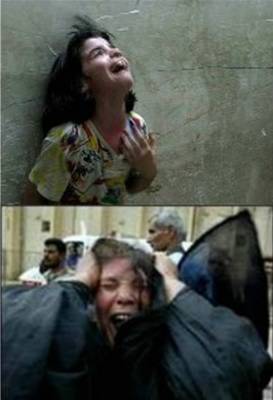"The Israeli government has referred to its siege policy as a form of
“economic warfare.” In a Nov. 2008 cable from the US embassy in Tel Aviv
released by WikiLeaks, US officials wrote, “As part of their overall
embargo plan against Gaza, Israeli officials have confirmed . . . on
multiple occasions that they intend to keep the Gazan economy on the
brink of collapse without quite pushing it over the edge” with the aim
of having Gaza’s economy “functioning at the lowest level possible
consistent with avoiding a humanitarian crisis.” This was achieved
through an Israeli-imposed blockade that ended all normal trade. The result has been high and persistent unemployment, which stood
near 30 percent by June 2012, according to the International Monetary
Fund. Approximately 39 percent of Gaza’s people lived below the poverty
line in 2011. The figure would be far greater without donor aid. Gaza’s economic decline is seen in the near collapse of its
agricultural sector. One factor is the destruction of around 7,800 acres
of agricultural land during Cast Lead. Consequently, approximately
one-third of Gaza’s total arable land is out of production. Furthermore,
Israeli-imposed buffer zones — areas of restricted access — now absorb
nearly 14 percent of Gaza’s total land and at least 48 percent of total
arable land. Similarly, the sea buffer zone covers 85 percent of the maritime area
promised to Palestinians in the Oslo Accords, reducing 20 nautical
miles to three, where waters are fouled by sewage flows in excess of 23
million gallons daily. Another critical constraint is water. Gaza’s aquifer has been ruined
by prolonged over-pumping and sewage and contaminant infiltration.
Almost all of Gaza’s municipal wells used for drinking water are seriously polluted. Due to the breakdown of Gaza’s sanitation infrastructure, particularly after 2008, this infiltration has led to elevated levels of nitrates and chlorides in the groundwater and soil — far above World Health Organization safety levels — posing a dangerous health risk to humans and livestock.
Israel’s blockade policy restricts the entry of materials needed to repair, maintain, and upgrade Gaza’s sewage and wastewater treatment infrastructure. Save the Children reported in 2011 that Israeli airstrikes destroyed water and sanitation infrastructure valued at $1.3 million.
The impact on health is clear: Just under 10 percent of Gazan children under five suffered from chronic malnutrition in 2010. According to Save the Children, “Diseases of poverty and conflict combined with a degenerating health care system are claiming growing numbers of Gaza’s children.”"
Almost all of Gaza’s municipal wells used for drinking water are seriously polluted. Due to the breakdown of Gaza’s sanitation infrastructure, particularly after 2008, this infiltration has led to elevated levels of nitrates and chlorides in the groundwater and soil — far above World Health Organization safety levels — posing a dangerous health risk to humans and livestock.
Israel’s blockade policy restricts the entry of materials needed to repair, maintain, and upgrade Gaza’s sewage and wastewater treatment infrastructure. Save the Children reported in 2011 that Israeli airstrikes destroyed water and sanitation infrastructure valued at $1.3 million.
The impact on health is clear: Just under 10 percent of Gazan children under five suffered from chronic malnutrition in 2010. According to Save the Children, “Diseases of poverty and conflict combined with a degenerating health care system are claiming growing numbers of Gaza’s children.”"








